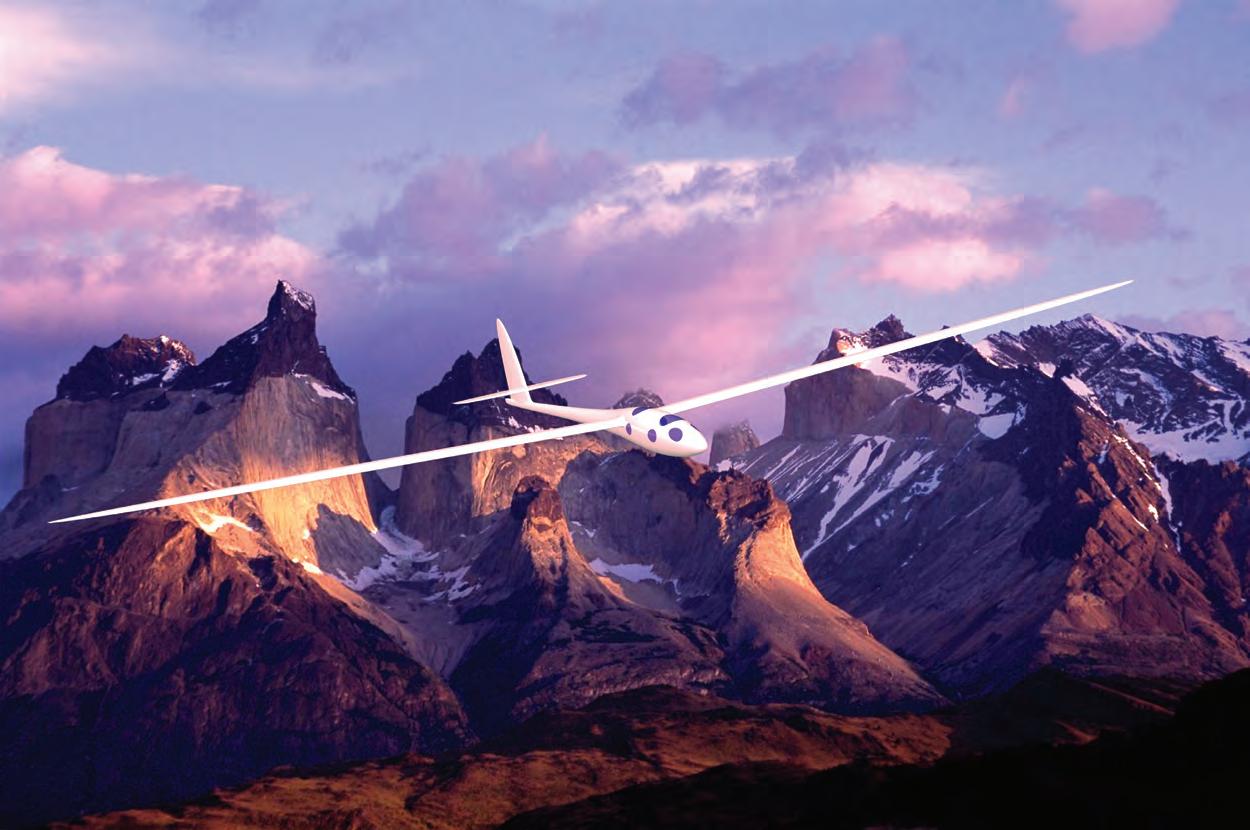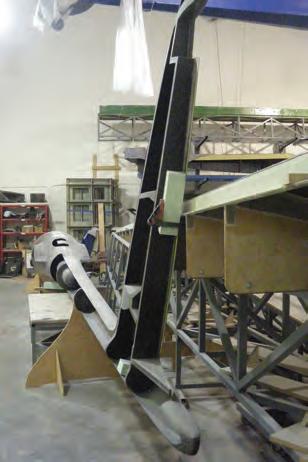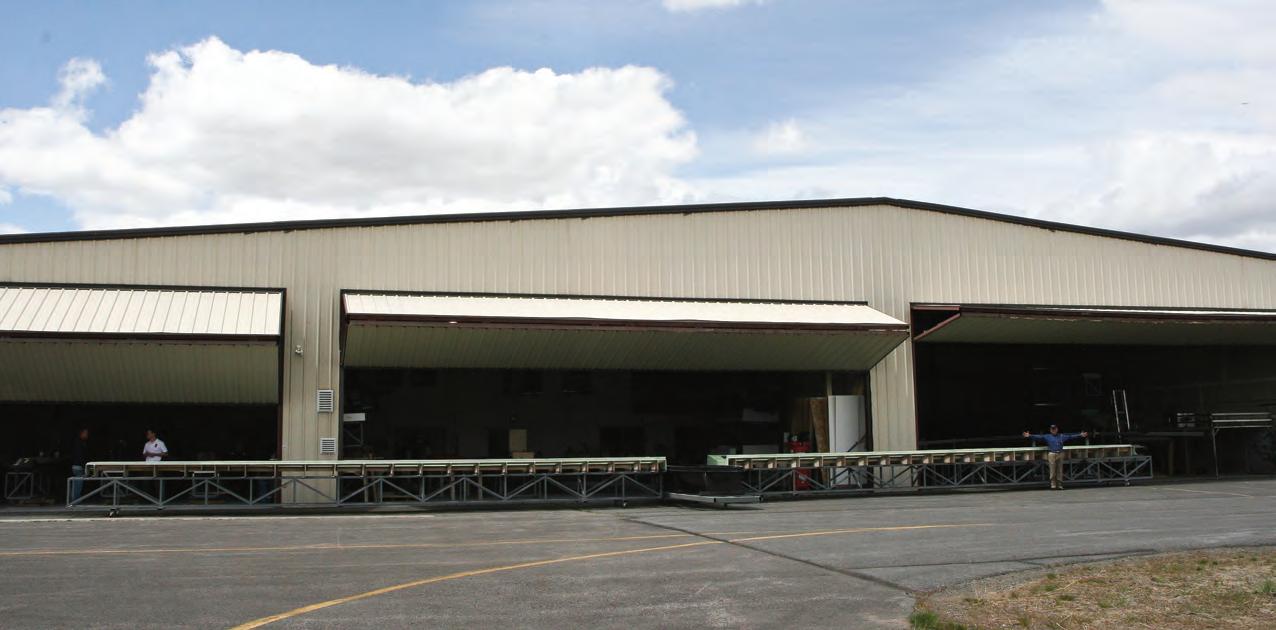
12 minute read
Perlan – Setting Records for Science
from SoaringNZ Issue 31
by mccawmedia
By Dean Sigler, Project Historian
The quest for records often helps advance science, and science often returns the favour. Perlan 2 makes advances in aeronautics and structures, to enable it to achieve record altitudes and monitor the high stratosphere in unique way – a signifi cant distinction from record seeking in balloons and powered aircraft. SoaringNZ brings readers an exclusive look at the history of the project and the current state of play.
Advertisement
Records and Data Seeking
Early balloonists, at untested heights, often found the upper air scarier than anticipated. In 1804, Joseph Louis Gay - Lussac, physicist, chemist, and balloonist, recorded several fl ights of over 20,000 feet, where he noted occasional states of unconsciousness and dizziness.
Dr. James Glaisher and Henry Coxwell, perhaps ignorant of Gay-Lussac’s reports, sought data on temperature and humidity at increasing altitudes in their September 1862 ascension over Wolverhampton, England, but found temperatures below -30° F, and had trouble breathing as the balloon climbed. Barely escaping with their lives, the pair had collected data on the levels at which clouds form, and the origins of rain.
Gaston Tissandier and his companions Croce-Spinelli and Sivel ascended to over 29,000 feet, and only Gaston survived the ordeal.
As aircraft matured, American, British, French, and Italian aviators began assaulting the heavens. June 30, 1938 marked Flight-Lieutenant M. J. Adams’ 53,937 foot record, fl ying a purposebuilt Bristol 138, only to have that achievement eclipsed by Lieutenant-Colonel Mario Pezzi’s record 56,032 feet in a Caproni Ca.161 biplane on September 22. Adams and Pezzi wore pressure suits resembling antique diving outfi ts, in which neither could escape the intense cold.
Sailplanes have reached the near stratosphere in recent years. Earlier pilots were constrained by what could be achieved with thermals and ridge lift, but the discovery of standing mountain waves changed those limitations.
Paul Bikle, Director at NASA’s Dryden Flight Test Center from 1959 to 1971, was a soaring enthusiast and president of the Soaring Society of America. In February, 1961, he reached 46,267 feet over China Lake, California, in his simple, unheated Schweitzer 1-23. Bikle had his son run his car’s heater at full blast in preparation for Bikle’s landing after two hours at -40° F temperatures.
According to NASA Dryden’s web site, “Bikle’s absolute altitude record for sailplanes was broken on Feb. 17, 1986 by Robert Harris, who reached 49,009 ft. altitude fl ying a Grob 102 over California City, Calif. The current record of 50,722 ft was set by the late Steve Fossett and Einar Enevoldson, as part of the Perlan project on August 30, 2006. Bikle’s 1961 record for altitude gained – 42,303 ft. – is still unchallenged.” With good reason. A former U. S. Air Force and NASA test pilot, Einar explains, “39,000 feet is the maximum limit for 100-percent oxygen, without leaks, and a perfect mask. One can then ‘pressure breathe,’ where the lungs are infl ated above ambient pressure, which keeps pressure in the lungs at 39,000 feet. You must force the air out to exhale – it gets to be a lot of work eventually.” Einar experienced poorly operating pressurisation systems that caused extreme discomfort at altitude.
An early ‘jerkin’ type pressure shirt was worn, with infl atable
Forms show flow of long, slender fuselage.

Kristin Kebbe Photo
Dean Sigler Photo Perlan fuselage assembly jig with forward fuselage of coming JetHawk derivative of DuckHawk.


Kristin Kebbe Photo Part of Perlan team stands with cabin mockup, which traveled across America to allow people to have imaginary rides in the stratosphere.
Dean Sigler Photo Perlan fuselage with whiffle tree on tail, weights in fuselage, prepared for simultaneous structural, pressurisation tests.

bladder to counter the internal pressure on the lungs, which squeezed blood to the lower extremities. “So you put on a G-suit (pants with bladders over your abdomen, thighs, and calves.) You will still faint in a few minutes, because blood still fi nds the un-pressurised nooks and crannies, and also just squeezes out of your veins into surrounding tissue.”
In Perlan 1, Einar and Steve wore slightly more comfortable astronaut suits, which barely fi t into their DG-505M’s already tight cockpit, with the suits’ unwieldy fi ngers and joints making manoeuvres diffi cult. Occasional over-pressurisation of a suit would force a hurried return to the airfi eld at El Calafate, Argentina.
Perlan 1 is retired, and suspended over a display celebrating the pair’s records at Seattle’s Museum of Flight – Einar’s in a wide range of aeroplanes, and Steve’s in ballooning, sailing and fl ying. Their impressive resumes fl ank the main exhibit hall, where an SR-71, in its fl at darkness, and an F-104 in NASA livery, refl ect Einar’s earlier experiences.
Perlan 2
Einar and Steve began planning a purpose-built sailplane, Perlan 2, to go after Einar’s original goal and climb to the realm of the nacreous cloud, an image sealed in his mind and hopes – a shining vision of high-fl own clouds, fi rst glimpsed in a picture in the offi ces of the DLR – the German Space Agency. Named for their pearlescent luster, these mother-of-pearl clouds fl oat at 25 to 30 kilometers (15.5 to 18.6 miles). Perlan is Icelandic for pearl.
He and Steve sketched out a pressurised sailplane which would enable more fl exible accommodation for the pilots, complete with an oxygen rebreather system, to enable fl ights up to eight hours.
Greg Cole was commissioned to build the aeroplane, and was busy with initial design, when tragedy intervened with the loss of Steve Fossett during a recreational fl ight near the Sierra Nevadas on September 3, 2007. Steve’s remains were found with the wreckage of his Super Decathalon a year later, near Mammoth Lakes, California. Building a Team
This devastated the Perlan effort. Steve had been not only an active participant, but a major funder. It looked as though the grand idea would not see fruition. Then, Morgan Sandercock, a coal-mine manager from Australia, stepped in, traveled to Bend, Oregon, made a major donation toward further construction, and became an active participant in the program.
The Project gained additional backing from many volunteers, who contribute their expertise and skills to organising and funding Perlan. Einar Enevoldson is Founder and Chairman of the Board; Greg Cole is Designer and Builder; Morgan Sandercock, Project Manager and pilot; and Ed Warnock provides organisational abilities as CEO, assisted by Business Manager Katrina Halverson.
Dennis Tito, with a B. S. in astronautics and aeronautics, and Master’s degree in Engineering Science, is a major contributor to the project and a future Perlan pilot.
Dr. Elizabeth Austin, Ph.D., Perlan’s Chief Meteorologist and Web Site Designer, heads Weather Extremes, Ltd., a major international meteorological and climatological research and consulting fi rm.
John David Miller, Vice-Chairman of the Board, is a Principal Engineer and Research Director at Intel, who pilots his own Mooney to Perlan meetings. Jim Payne, Chief Pilot, has fl own a
SparrowHawk, another of Windward Performance’s aircraft, to no less than nine world records, and was outright winner of this year’s online competition for soaring. Doug Perrenod, Board Member, while a Lt. Colonel in the U. S. Air Force, 3D modeled countermeasures for head, neck and spinal cord injuries during seat ejection.
Patrick McLaughlin of Mountain High Oxygen, applied his skills to produce lightweight, compact oxygen systems, and his knowledge of physiology to the cabin pressurisation system. James Murray, a NASA researcher, worked along with Jeff Bozanic on rebreather systems and instrumentation. Michael Batalia adds his fund-raising expertise and contributes to instrumentation efforts. Curtis Ritchey gains valuable publicity for Perlan through his outreach ef forts as Social Media Manager. Stephane Fymat, team member and newsletter editor, ‘publishes’ a valuable chronicle of the project through his bi-monthly newsletters on the Perlan web site.
Eric Greenwell, long-time sailplane pilot and frequent contributor to Soaring magazine, is a board member. Roger Tanner, F-16 pilot and chief instructor at the Air Force Test Pilot School at Edwards AFB, and sailplane pilot, shares his skills in developing a test fl ight program for Perlan. Crafting a High-Altitude Sailplane
Perlan is a stratospheric soarer, with pressurised cabin for two, and true airspeeds normally associated with business jets. With no engine other than rising air currents, Perlan at its best L:D at 90,000 feet will travel at 275 knots (316.25 mph). Putting the nose down, it will pick up speed quickly, but that confronts the delicate balance between reaching fl utter speeds or slowing to a stall in the thin air, all but two percent of the world’s air below.
Greg Cole created a series of airfoils tuned to the weak atmosphere and high true airspeeds; optimised for their positions on the wing, different from those for aircraft that never touch the stratosphere.
Perlan must be strong enough to manage extremes of cold, turbulence, and the simultaneous stresses of cabin pressurisation and fl ight loads on the airframe.
It must maintain a cabin pressure of 8.5 pounds per square inch, equivalent to 14,000 feet at altitudes up to 90,000 feet, provide oxygen for an eight-hour fl ight, and include various safety measures to allow rapid and safe return to lower altitudes. Pressure testing in May proved that Perlan’s cabin area could retain structural integrity even if the rear pressure bulkhead cracked. This was with thousands of pounds in the cabin, over pressurisation, and structural loads beyond anticipated maximums.
Perlan is 1,100 pound empty, 1,700 pound loaded, with a wingspan of 84 feet and wing area of 262 square feet. Its 32.8 foot long fuselage contains two people, scientifi c and recording gear, and life support systems such as dual-redundant oxygen rebreathers. Because water vapor from exhalation could freeze in the cold cabin, dehumidifi cation protects equipment and pilots.
Built from expensive carbon fi ber fabric pre-impregnated with resin (pre-preg), the shell of Perlan resembles a herringbone-woven sleek black fi sh, its vertical tail like the swooping of a dolphin.
Perlan 2 could not compete with large conventional sailplanes, optimised to combine speed and high lift at lower altitudes. Its broad and lightly loaded wings will fi nd a more fi tting setting in the stratosphere.
Workers lift upper wing skin for inner wing panel.

Fuselage structure

Perlan Project Photo

Outer panel completes one side of four-piece wing.
Perlan Project Photo Overflow crowd filled ballroom at 2012 Soaring Society of America convention for Perlan presentation.

Perlan has high altitude mechanical altimeters and radar transponder, instrumentation and lighting to allow night fl ight, data loggers to validate the hoped-for world record altitude, and scientifi c instruments to record ambient conditions outside the cabin.
A drogue parachute will enable a high-altitude emergency descent, and a ballistic parachute will save Perlan and its occupants at lower altitudes. A tail-mounted camera will supplement the view during landings. What to Do With a Special Airplane
Perlan’s web site proclaims: “Soaring to the edge of space and into the ozone hole.”
“Our mission is to soar up to 90,000 feet using stratospheric mountain waves and the Polar Vortex. We are building a special pressurised high altitude sailplane in Bend, Oregon. In August 2014 we will make the fi rst attempts to reach 90,000 feet in El Calafate, Argentina, the same location as our 2006 record-setting fl ight,” where they had been able to exploit the high mountain waves.
Elizabeth Austin’s prognostications showed that New Zealand and southern Argentina held the most promise for achieving record heights, but conditions over Omarama, NZ, had disappointed because upper air winds did not cooperate.
Einar notes, “We were not successful in New Zealand on our fi rst attempts but we have not ruled out further exploration there in the future. In 2013, NCAR will be fl ying the NOAA Gulfstream 5 from New Zealand, for further research on stratospheric mountain waves in the Polar Vortex”, giving more insight into the potential for stratospheric waves from New Zealand.
El Calafate held promise because the Andes mountain range can provide sustained high-altitude mountain waves – hence the change of venue and the serendipitous timing that led to the world



record, touching the bottom edge of the stratosphere.
Perlan 2, still under construction, awaits its trip to South America. The 40 foot shipping container that held the 31.2 foot fuselage during its pressurisation tests will carry it, wing panels and attendant assemblies, for its sea voyage. Getting batteries, oxygen and other necessary equipment into a foreign country requires careful planning and documentation.
Perlan will be aero-towed to its release point as with any sailplane. The pilots will then fi nd mountain waves that will lof t them to a connection with the Polar Vortex, an intermittent ring of fl uctuating air that circulates over the poles.
Weaker in the polar winters and stronger in the summers, the vortex needs to be there when needed. Elizabeth Austin will have to predict airfl ows at varying altitudes, circumstances favorable to mountain waves, and other factors that will make it possible to break records.
Perlan 2 will carry its crew on a grand adventure, enabling a record altitude and collection of data that might help us understand global weather, the ozone hole, and how various natural and man-made additions to the atmosphere affect these planetary health indicators. Perlan, because of its ability to maintain level fl ight at heretofore unclaimed altitudes, could provide signifi cant input to our knowledge of the upper atmosphere and its effects on global climate.
See the Perlan web site at www.perlanproject.org and consider making a donation to this worthy cause.
Perlan CEO Ed Warnock stands at extreme right of 84-foot wing assembly jig.











